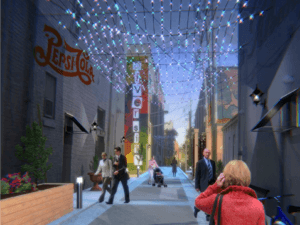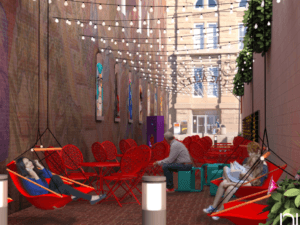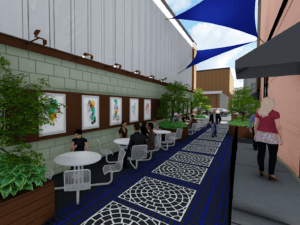Chelsea Schneider, Municipal Innovations Specialist
Hoosier alleyways are experiencing a Renaissance.
Re-imagining the narrow streets into public spaces with artwork and seating is a growing trend as cities and towns look to redevelop their downtowns. With the rise in popularity of the projects, alleys are no longer cut-throughs to somewhere else, they’re destinations in themselves.
They’re an unexpected nook as visitors walk down the street. And a well-lit path on the way to shopping or an evening out at a nice restaurant. More and more, communities are showing alleys are no longer just the place to keep the dumpster – they’re blank canvasses for community development.
“The trend is part of the overall process of downtown revival,” said Michael Burayidi, an urban planning professor at Ball State University. “The idea is to try and make downtown a destination not just for people who live in downtown but so cities can attract people who live in suburbs back to shop in downtown. These spaces allow for chance encounters.”
Here are four alley transformations to watch:

Madison
Community leaders didn’t want downtown visitors to feel like they were walking through an alley on their way to Main Street shops and restaurants.
So they spruced the popular connection up. Pedestrians now enter the alley through an arch, with café lighting strung back and forth, and walk on the same brick pattern used on Main Street.
Eventually, the city hopes to plan musical acts in the alley.
“In small communities, we’re about seeing what we can do to utilize space we already have – especially if it’s in the downtown area,” said Andrew Forrester, Madison’s community relations director.
The project also carries practical benefits. Several benches provide flexible seating space, especially during the popular Madison Chautauqua Festival of Art.
“We are looking at doing projects like that because it adds to quality of life,” Forrester said. “Especially for a small community that is where we have our competitive advantage, if we can make a place where people look at and say, ‘This is awesome. I want to live here.’”

New Albany
Downtown New Albany has experienced a transformative redevelopment over the last several years.
Now the city is planning to turn an alley in the heart of downtown into an attraction of its own. The alley is already a popular walkway for downtown visitors heading to restaurants and retail, so the city wanted to increase its aesthetics and safety features.
The project includes more than 1,000 Edison-style droplights, artistic enclosures for dumpsters and concrete pads for movable sculptures. The new features also will extend down to the pavement, which will be resurfaced and decorated with colorful patterns.
Through the project, the city also plans to rehab “ghost signage” – faded advertisements painted on buildings. Many of the ads are located in the alley.
“It’s an underutilized area that now is going to be more of an attraction,” said David Duggins, director of redevelopment and economic development for New Albany. “When it’s completed, it will be an inviting space where people can take their time to decide where to eat or shop.”

Tipton
Tipton leaders wanted a way to bring people downtown – to get them outside and interacting.
In their travels across the state, they saw alley projects and asked “How can we get one in our rural community?”
The goal: To drive people downtown for events, shops and restaurants. To achieve it, the community crowdfunded $23,000 through an Indiana Housing and Community Development Authority tool called Patronicity. The state then provided a match, bringing the project total to $43,000.
Soon, the corridor will turn into an intimate setting to relax in downtown, featuring art, a custom “Love Tipton” bench and an archway branding the area as “The Alley.” Rounding out the project will be additional seating, decorative lights and stamped concrete.
Project organizers hope the alley improvement makes people want to come and hang out in Tipton. Farm-to-fork dinners, movies and other events already are in the works for the alley.
“Millennials are looking for unique experiences,” said Nathan Kring, director of Tipton County Economic Development Organization. “They don’t necessarily want cookie cutter. They want urban environments.”

Warsaw
A few years ago, a group of Ball State students came to Downtown Warsaw to sketch different ideas for the city. One of those sketches showed an alley developed to host various events and outdoor seating.
“A space outside where people can come with a laptop and sit during the day to do some work,” said Justin Taylor, Warsaw’s assistant city planner.
When Taylor traveled to Europe, he saw alleys primarily used for shopping and vendors. The alleys showed Taylor that not all streets need to be designed around cars – pedestrians are important, too.
“It will be great for tourism and visitors to downtown walking down the street and seeing an unexpected nice space to view art, or sit outside and meet up,” he said.
Like Tipton, Warsaw raised money through Patronicity, bringing in nearly $59,000 locally for the project and receiving a state match.
The project features new tables and chairs for downtown visitors, landscaping, rotating artwork and wireless internet. Plans also call for new bike parking. The parking will support group bike rides, including a weekly event where riders park downtown to visit shops.
And the impact of those improvements are expected to extend well beyond the alley.
“It ties into community and creating vibrant community spaces,” Taylor said.
